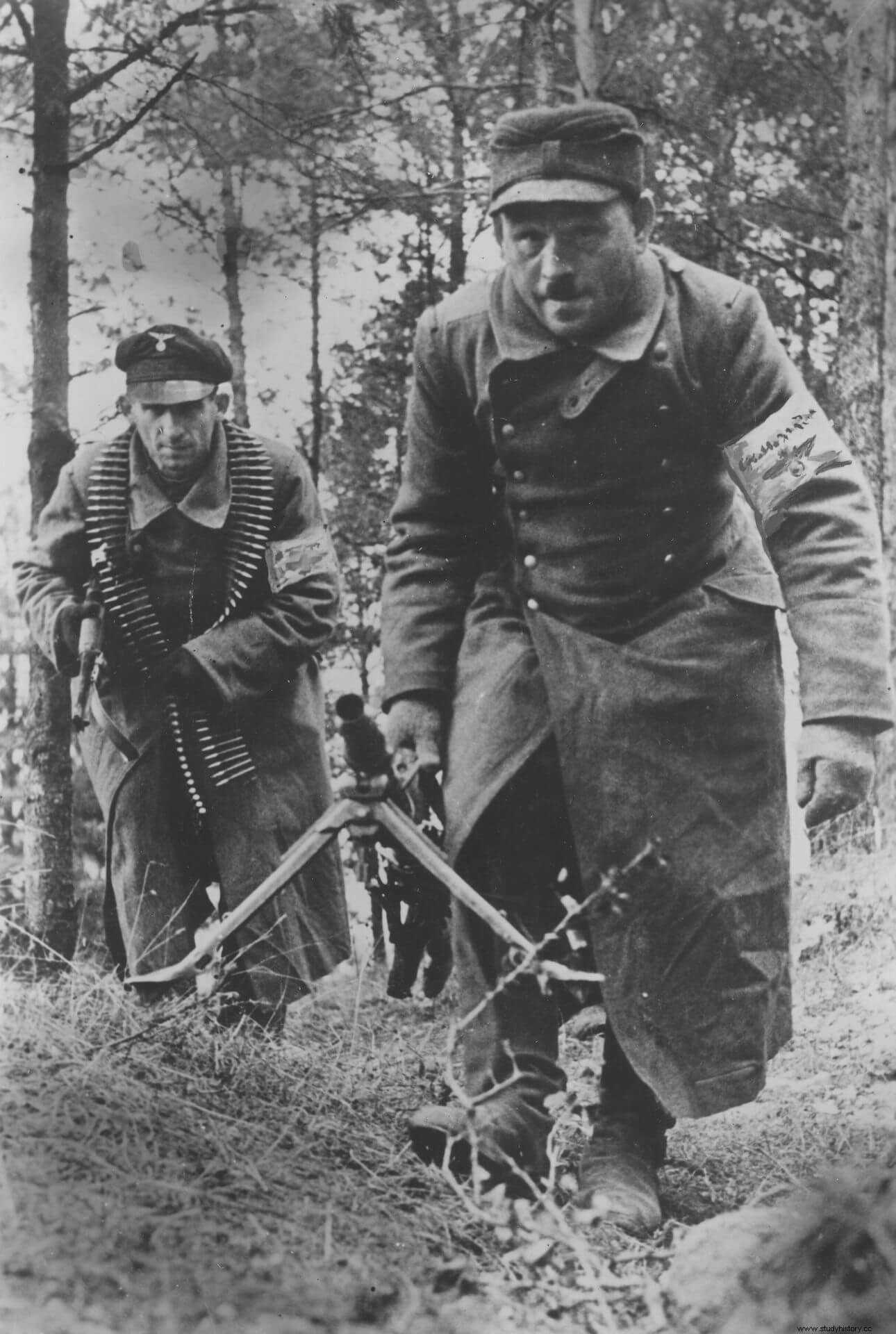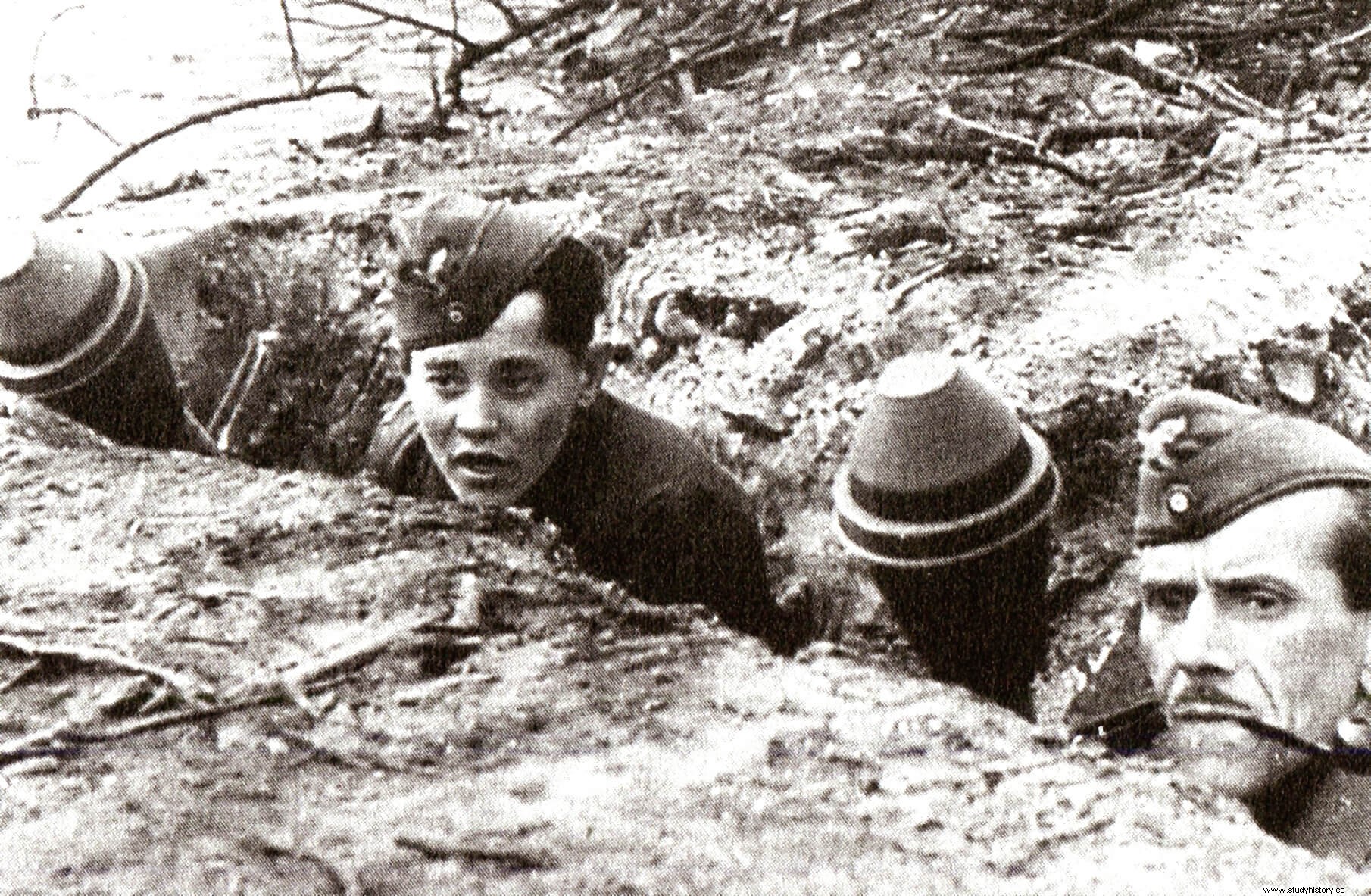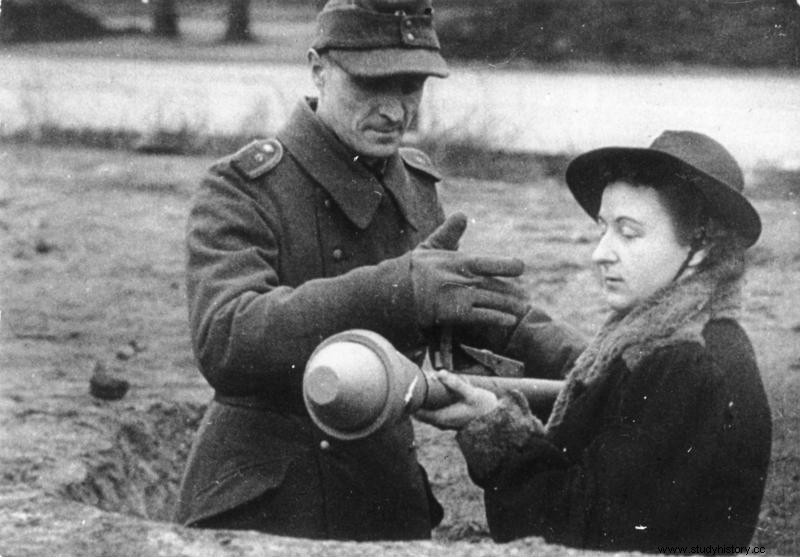
If Hitler had been losing confidence in his generals Throughout the war, the failure of the assassination attempt on July 20, 1944 ended the little credit they still had with their Führer, who decided that that body of professionals, treacherous and lacking in faith, should be cornered in favor of a new army, more convinced of victory, more fanatical. There were two paths chosen by Hitler to obtain what he wanted. On the one hand, he ordered the SS to be reinforced, expanding its possibilities of recruiting and creating new units by transferring officers and putting Heinrich Himmler, its chief, in command of the Einsatzheer (the "replacement army"), which was the one that It was in charge of replenishing the troops lost in combat by the Wehrmacht. The other was the creation of the Volkssturm . It is important to note that the original idea came from Heinz Guderian, who at the time was chief of the General Staff of the OKH. He proposed to Hitler the creation of a militia force, which would be trained and organized by the SA (Sturmabteilung, the shock force of the Nazi party, although its power had been declining in favor of the SS) and would be under the command of the army. . At first the dictator opposed the idea, but he soon changed his mind, and on September 6, 1944, the Landssturm was created.
The organization of the Volkssturm
It didn't last long. One of the characteristics of the political-administrative system of the Third Reich was the division and constant struggle between political positions for plots of power, and the Landssturm It didn't take long for her to become one of his victims. The hare was raised by Martin Bormann, Hitler's personal secretary and de facto head of the Nazi party, when he stated that, under the control of the army, the men of the new militia would lack the motivation and fanaticism to fight to the bitter end. in the end and under any circumstances, and that they had to be brought under the control of the party in order for the party to secure its ideological conviction. On September 25, Hitler issued a secret Decree reordering the newly formed militia, and on November 18 this was ratified by an official Decree signed by Heinrich Himmler. The Landssturm had become the Volkssturm. Unfortunately for this new military force, internal struggles soon pulled it in all directions. Hitler himself was the one who caused the problem, because in his Decree he put the organization of the Volkssturm in the hands of the party, that is, Martin Bormann, who delegated the task to Wilhelm Friedrichs; but he assigned the military management of it to Heinrich Himmler, who also delegated it to his chief of staff, Gotlob Berger. A bicephaly was not enough, of course, and it was not long before the new service found itself intervened by Dr. Robert Ley, head of the Deutsche Arbeitsfront ("German Labor Front"), by Wilhelm Schepmann, head of the SA, who undoubtedly resented the loss of authority that the disappearance of the Landssturm meant, and Albert Speer himself, Minister of Armaments and War Production, who was the one who, in the end, had to arm this new force.
The creation of this militia was conditioned by two opposing principles. On the one hand, the official machinery of Nazism wanted them to be convinced, fanatical fighters, in the style of the Japanese soldiers deployed in the Pacific islands, willing to fight to the last man without ever backing down, a concept fully promoted by Hitler. Hence the name Volkssturm was born, popular storm, popular assault, in which the idea of Volkskrieg (“war between peoples”) was emphasized. so dear to National Socialism. The other principle at stake was that of military effectiveness, since the mere deployment of a human mass without the necessary skills for combat was useless.

Trying to comply with both principles, they would be recruited in the Volkssturm all men between the ages of 16 and 60, including all those who had been exempted from previous drafts because of the economic importance of their jobs or in supporting the military machine. To alleviate the loss of these assets, it was agreed that the action of this militia, organized in battalions, would only be local, so that the Volkssturm soldiers could, once trained, continue with their occupations until the enemy approached. to his combat zone. In fact, to further refine this concept, the militiamen were divided into four groups. Group I and II were made up of those who were fully trained, who were classified according to the importance of their occupation in civilian life to fight in the area of the entire region (Gau, group I), or only locally (Kreis, group II). Group III was made up of the youngest, members of the Hitlerjügend , which in a new example of the Reich polycephaly came under the control of this organization and were very often evacuated from the combat zone before becoming integrated into their Volkssturm unit (although on other occasions, such as in Berlin, they were fought), and group IV went to those who had some physical disability. The latter were only used for security tasks at the local level.
We have already indicated that the base unit was the battalion. This was left under the command of a Bataillonsführer appointed by the Kreisleiter (“local party chief”), which was divided into three companies (commanded by a Kompanieführer ), of three sections (Zugführer ) with three squads of nine or ten men (Gruppenführer ). This organization was not fixed, but rather varied according to the population corresponding to each battalion, by virtue of which it might be necessary to create more companies. Neither were the above positions true military ranks, and for the most part they were handpicked by the superior commander. The criteria for choosing these commanders were the result of the dichotomy discussed above:it was convenient for the combatants to have some military experience, but the Gauletiers , their political bosses, slept much more peacefully if they were convinced Nazis and, consequently, were willing to fight to the bitter end.
Popular rejection, logistical shortcomings
For practical purposes, the idea of the Volkssturm did not excite the Germans. Many of those who until then had been exempt from joining the ranks realized that their luck was running out and, in general, the concern spread as to whether they would be regular soldiers, subject to the obligations and, above all, to the protection of international treaties, or not. Himmler's speeches hinted that they would fight at the front but also behind enemy lines, which could make them guerrillas and, if so, they risked not being recognized as combatants and shot after being captured.

In addition to those mentioned, there were various factors that undermined the morale of those called to the Volkssturm. First, the lack of uniformity. The Hague treaties indicated that the presence of a distinctive sign visible from a distance was sufficient, but for many the armband with the words Deutscher Volkssturm did not seem sufficient. The absence of a uniform and the need to show up with one's own clothes also had its deterrent effect, because at that time quality clothes were very scarce in Germany, so either the Vokssturmann he was cold and wet, or he risked ruining his best clothes already from the training phase. Another dissuasive element, already advanced above, was that of the controls.
Both for training purposes, where a professional soldier was always clearer about what recruits needed to know and what they didn't, and for combat purposes. It is not difficult to imagine the impression that the figure of a Gruppenführer must have made on any office worker not inclined to go to war. willing to force him to make the last of the sacrifices in the name of a country that was dying. Finally, the question of armament was also vital. At the beginning of 1945, Germany suffered serious shortages of all kinds of weapons , especially rifles and machine guns, so most of the battalions were equipped with old materials. That said, it is worth highlighting two pieces of the panoply used by the Volkssturm. On the one hand, the Panzerfaust hollow-charge grenade launchers, which were distributed with great generosity and which, for these soldiers, represented a real lifeline, since with them they were able to face enemy armor. On the other hand, although scarce, the MG 42 machine gun caught the attention of those who could use it, whose sound was like ripping a piece of paper, unlike the rattling sound they knew from previous wars.
The Volkssturm at the Battle of Berlin
As far as the battle of Berlin is concerned, a new character joined the organizational chaos of the Third Reich, Joseph Goebbels , who, with the bombastic title of Reich Defense Commissar for Berlin, put himself in command of the city's Volkssturm. "The Führer's call is a holy order for us." "Believe! Fight! Win!" Lofty phrases that the newsreels fused with tight ranks of future Panzerfauste-armed fighters and that turned the Propaganda Minister's diatribes into highly credible statements for Berliners. The advertising hook worked in part, the rest would do the threat of being treated as deserters that weighed on all those who did not attend. In total, of the approximately 41,000 defenders of Berlin, 24,000 could have been from the Volkssturm, which reached as many as 200 battalions, although 90 is a more credible figure. In both cases, if we take into account that a battalion should have around a thousand men, a little less, we can deduce that these "battalions" were never such, but mere names.

In any case, the performance of the Volkssturm in Berlin It was highly irregular. Various reports from Wehrmacht units indicate the presence of battalions or companies of this militia on one of its flanks, and then their disappearance. It makes some sense if we consider that the Volkssturm units were divided into two groups to begin with, Group I, made up of those with weapons, and Group II, made up of unarmed men. And although the logical thing would have been to send the latter home, in reality they were concentrated in the center of the city, waiting for weapons to be found to equip them. In the end, it was quite common for many of these poorly trained men to become demoralized and abandon their posts, especially when their Panzerfauste stock ran out and they were powerless against Soviet armor and quickly concluded that they had fulfilled their mission. part and it was time to go home.
It is extremely difficult to keep track of all the units that fought around and within the city. The documentation is scarce, since there was not much and a large part of it was lost during the fighting, a situation to which must be added the circumstance that very often the Volkssturm unit was named after the surname of its leader, from so that, if he fell or was replaced, a new chief gave a different name to the group. Still, it can be narrowed down a bit. The maps of the time indicate that one of the sectors in which these units were especially important was that of Potsdam and the lakes of the Havel River, where a corridor was kept open that allowed the escape to the southwest, until Wenck's Twelfth Army , of many fighters. There were also units that stood out, such as one identified by the name of the Hitler-Jugend Tank Destroyer Brigade, a force made up of children and young people armed with Panzerfaust that I never got to have the strength of a brigade. We also know of the existence of the 3/115 Siemensstadt battalion, which together with the 3/121 battalion formed the 57th Fortress Regiment and was made up of almost 800 veterans of the Great War, mostly factory workers in the neighborhood. of Siemensstadt. Under the command of the Major Erich Krull, this unit, made up of three battalions and which even had some cannons, was deployed in Kaulsdorf, to the east of the city, where it established contact with the Soviet troops, whom it fought, in constant retreat, for the Friedrichsfelde Ost railway station, the districts of Lichtenberg and Friedrichshain and on Schönhauer avenue, where the last fighters of the unit were captured.
By way of conclusion, it should be noted that the success of the Volkssturm was highly erratic . Some battalions fought excellently, they were those that were formed by convinced Nazis, well led and lucky enough to have acquired modern weapons, or an immense number of Panzerfausts; but the action of the vast majority was discreet, so much so, at times, that, as many reports from Army officers testify, many battalions dissolved at the first shot. No one wants to be the last dead in a war.
